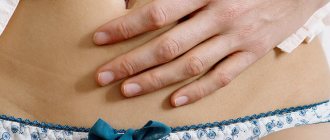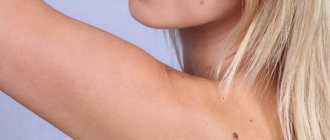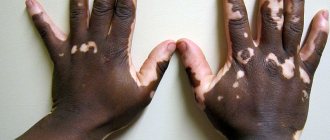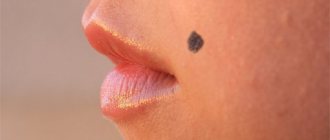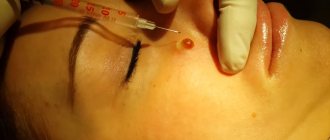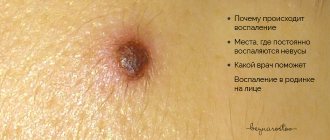A painful mole is a reason to consult a doctor as soon as possible to identify the cause of the unpleasant symptom. Causes for concern are discomfort and changes in the appearance of the pigment spot. Properly selected therapy will stop dangerous processes and prevent the development of oncology. A mole, according to medical terminology, is a benign formation. Nevi exist on the body of every person. In most cases they are not dangerous.
Types of nevus
A mole can be acquired or congenital. The latter are usually inherited from parents. Their shape, color and size are different. But throughout life, nevi can appear due to various factors:
- high levels of radiation;
- hormonal imbalance in the body - during pregnancy, puberty and serious illnesses;
- genetic predisposition;
- excessive dose of ultraviolet radiation.
There are two classes of moles - nonvascular and hemangiomas.
The latter appear due to damage to blood vessels and are pink or red in color. Capillary nevi are located on the surface of the skin, and cavernous nevi grow under the upper layers of the epithelium. Non-vascular formations have any shape, they can be flat or hanging. Sizes range from microscopic dots to huge spots. Some moles may appear without any reason; they do not pose any danger.
What causes hanging moles?
The reasons for the appearance of such neoplasms are quite varied. This is usually a consequence of melanin clumping in the skin cells. Several factors can provoke this condition.
- Mechanical injuries.
- Excess body weight and poor nutrition.
- Diabetes mellitus type 2.
- Hormonal imbalances. They are especially strong during pregnancy, adolescence, menopause, polycystic ovary syndrome, etc.
- Frequent stressful situations. Very often, hanging growths appear after strong emotional overstimulation.
- The presence of HPV or human papillomavirus in the body.
- Steroid overdose leading to improper formation of collagen fibers.
- Hereditary predisposition.
- Coca's disease.
- Negative effects of ultraviolet rays and radiation.
Knowing why moles form on the body will help protect yourself from them and the complications associated with them.
Regardless of the reason for the appearance of moles, for the time being, they do not pose any particular danger. But under certain circumstances they can degenerate into a cancerous tumor. Therefore, you should be attentive to any unpleasant symptoms, such as discoloration or severe pain. The risk of transformation of a benign growth into a malignant one is increased in several groups of people. These are those with fair skin, female representatives, those who have received thermal or chemical burns, and those who like to sunbathe under the scorching sun.
Plus, such growths cause some discomfort.
- Due to friction, they are injured, which leads to pain.
- Twisting of the leg impairs blood circulation, which leads to swelling and pain.
- Moles that are too large are often injured and inflamed.
In addition, many moles in open places spoil the appearance.
Reasons for the changes
Nevi are usually harmless and are considered harmless. But if a mole hurts when touched, it begins to turn malignant. This is due to factors that provoke the occurrence of cancer. The risk increases for those who like to spend a lot of time in the sun and tan. From ultraviolet radiation, moles grow and change their structure.
Scratches and injuries can turn even the smallest nevus into a dangerous formation, so you need to periodically inspect moles in hard-to-reach places - feet, elbows and knees, where clothes or shoes rub. If one of your relatives had melanoma, then the descendants may develop cancer.
Hormonal drugs provoke the appearance of new formations, as well as changes in existing ones. Most often this occurs in pregnant women, during problems with the endocrine system and menopause.
Healthy moles cannot be painful; if you feel discomfort when pressed, you should consult a dermatologist.
What to do if a mole starts to hurt
If you have a sore mole, you should not try to relieve the pain or relieve inflammation on your own; you should consult a specialist.
When visiting the clinic, you should not stop at a doctor’s consultation, during which the doctor will explain to you the reasons for this condition of the mole; after it, you must undergo tests in order to find out the nature of the mole, prescribe a course of treatment and explain the possible consequences of its removal.
Expert opinion
Sakania Luiza Ruslanovna
Dermatovenerologist, cosmetologist, trichologist
Ask a Question
Most often, after examination and testing, a painful mole is removed; at the moment, there are several methods, the main of which are removal using a laser, liquid nitrogen or electric current.
In order to be completely sure that the mole will not appear again, you should undergo a course of chemotherapy, if prescribed by your doctor.
The main goal of chemotherapy is to completely stop or at least slow down the growth of cells that multiply to form a tumor, because even after the mole removal procedure, they can remain in your body.
Although at the moment, the methods of modern medicine to combat moles show good results, since they can determine the depth of their location before removal.
Danger signs
Nevus have pain receptors that respond to chemicals, shock, and temperature changes. If a mole hurts when pressed precisely because of these factors, then it is necessary to take measures to reduce the discomfort. In case of injury, the skin area is treated with hydrogen peroxide; the substance will prevent infection from entering the body. A special cream is applied to the burns.
Hanging nevi are damaged every day, so they can hurt almost constantly. The causes of discomfort are touching and friction with textiles. It is better to remove these moles. If the growth accidentally breaks off, the damaged piece should be placed in a clean container and taken to the hospital for histological examination. The doctor will prescribe medications to eliminate inflammation.
If a mole has enlarged and hurts, changes in the body occur at the cellular level. This is an unusual phenomenon that needs to be investigated. Dangerous symptoms are:
- thickening of the skin under the nevus or its enlargement;
- the appearance of asymmetry, change in spot area;
- redness of the epithelium around the mole;
- formation of cracks, peeling or release of fluid on the surface of the nevus;
- changes in shade or appearance of other colors;
- sensation of itching and burning.
The presence of even one sign is already considered a reason to consult a doctor.
Pain as a sign of malignancy of a mole
Malignization is a dangerous process of malignancy of a nevus; a normal cell of a benign tumor begins to change and acquires malignant properties. The result is melanoma. Cancer is the second most common cause of death. Capable of affecting adults, children, and the elderly.
Melanoma affects the body in different parts. It develops quickly and affects the skin, internal organs, and bones. A timely visit to a doctor will help identify the pathological process in the early stages or prevent its onset.
Dangerous symptoms:
- the surface of the mole becomes covered with cracks and knots;
- the appearance changes - the dense structure becomes spotted;
- the shape of the edges changes from smooth to jagged;
- color changes - redness or darkening;
- peeling appears;
- bleeding;
- touch causes pain;
- purulent or clear liquid accumulates near the nevus or under it and begins to come out if you press the growth with your finger;
- size has changed - drying out or rapid growth;
- compaction;
- swelling;
- redness of nearby tissues.
If you have the symptoms described, immediately go to a dermatologist-oncologist. The specialist will analyze the tissue for histology and remove the dangerous tumor-like growth.
The clinical picture is typical for melanoma; it is not a reason to despair. The mole hurts because of nerves; the receptors are most susceptible to external stimuli. Only a doctor will determine the true cause.
Diagnosis of moles
When identifying unusual formations, the patient is lost and does not understand what to do if a mole hurts. First of all, you need to be examined by a doctor, take all the tests and wait for the results. First, the doctor will visually examine the danger zone; a dermatoscope will allow him to see all the details of the change.
Then he takes a swab from the nevus, which is bleeding or secreting pus or fluid.
Moles located in the lower layers of the epithelium are studied using computed tomography. A simple examination is not enough for such formations. The last stage of diagnosis is analysis for the presence of tumor markers in the affected area. Based on the results, the doctor makes a diagnosis and determines the type of therapy for the patient.
What can cause pain
If a mole hurts, this does not necessarily mean that the causes arose very recently; the factors contributing to the pain may have occurred quite a long time ago, but no symptoms arose. In some cases, they do not appear if nothing happens that provokes discomfort. In addition, provocateurs accelerate the process of malignancy if it has already been started.
Firstly, the occurrence of previously hidden pain when pressed can be influenced by an addiction to any type of tanning - natural (sun) or artificial (solarium). It was found out quite a long time ago that ultraviolet rays negatively affect the skin; dermatological diseases and various neoplasms appear with excessive tanning. For this reason, those who strive to have bronze skin all year round can develop health problems, including the formation of malignant tumors.
Secondly, any chemical effect on a mole can trigger pain. This includes low-quality cosmetics and personal care products, household chemicals, as well as inappropriate traditional medicine recipes. In this case, the nevus receives chemical damage, which may cause pain from previous injuries or other causes.
If there are many potentially dangerous moles on your body, it is advisable to take timely care to ensure that they are not damaged and that you do not subsequently have to consult a doctor with complaints of pain. To do this, you only need to follow simple recommendations: firstly, reduce your time in the sun, try not to sunbathe from 11 am to 4 pm, use sunscreen and use natural cosmetics.
Preventive actions will reduce the risk of malignancy of old and the appearance of new nevi.
Treatment options
The most effective treatment for nevus is removal. The operations are carried out in a few minutes, and recovery takes no more than four days. But the period depends on the quality, depth and size of education. Modern medicine distinguishes several methods of surgical intervention:
- laser;
- radio waves;
- electrocoagulation;
- cryodestruction;
- surgery.
Laser therapy is suitable for removing moles on the head; it allows you to control the depth of penetration of the rays. There is no pain during the operation; the procedure lasts about 10 minutes. After healing there are no scars left. But the quality of the operation directly depends on the power of the medical equipment.
Radio wave therapy is a quick and painless way to eliminate moles on the back and other parts of the body. The doctor may take tissue for examination and then perform the procedure. The operation takes about 15 minutes, and the patient recovers within a few days. No scars remain. Only convex nevi can be removed; it is not suitable for flat ones.
Electrocoagulation is considered a painless procedure. The doctor independently controls the depth of current penetration. But it will not be possible to remove large moles or those that have grown into the lower layers of the epithelium in this way.
Cryodestruction is the use of nitrogen. The substance can eliminate nevi of any size and depth in just a few minutes. A dense crust forms at this site, protecting against infections; it will fall off over time. But the method has some disadvantages: after the wound heals, scars may remain, and a repeat procedure will be required, since during the operation it is impossible to control the depth of action of nitrogen . Sometimes healthy tissue near the mole is affected, which will only worsen the situation.
Malignant tumors, regardless of where they may grow, are removed only by surgery. Surgeries allow you to remove nevi from the deep layers of the skin, this eliminates the recurrence of inflammation. The patient must be given local anesthesia or anesthesia. After the procedure, stitches are placed on the area of removal; in almost all cases, a scar remains.
All methods, except the last one, are suitable for eliminating benign formations. Only surgeons remove melanoma; after the operation, they prescribe chemical or radiation therapy, which will prevent the patient from getting sick a second time.
Why does a mole start to itch?
Pigmented spots, tubercles - this is what almost all nevi look like. There are flat and convex, with a wide base, with hairs or smooth. Many pigmented skin structures are potentially dangerous in terms of malignant degeneration.
Therefore, when a mole on the neck or décolleté area itches, it is necessary to eliminate its irritation with scarves and jewelry. Dermatologists note that nevi, on the surface of which hairs grow and skin lines are visible, are less susceptible to changes.
It’s bad if a mole itches for no obvious reason and then changes color. Darkening indicates a malignant transformation of the formation.
Experts name a number of factors that cause changes in the pigmented structures of the skin:
- usually inflammation occurs after damage (scratches, cuts, burns, compression);
- the balance of hormones is disturbed, which is why a pregnant woman’s mole itches;
- peeling, scrub, massage have an irritating effect;
- internal disease activates melanocytes in the skin;
- received a high dose of ultraviolet radiation.
When a mole on the back itches, the main reasons should be sought in excessive exposure to the sun without clothing and excessive sweating. Alarming symptoms are changes in size and shape, the appearance of blurred edges instead of a clearly defined edge of the nevus. A mole hurts and itches most often due to injury or the process of malignant degeneration. A persistent burning sensation and painful tingling in the area of the nevus are symptoms of melanoma (skin cancer).
Preventive measures
If the removal was cosmetic, the healing process takes no more than 10 days. There are no traces left at the operation site, and the patient does not feel any discomfort. After surgery, the results depend only on histology tests. If they do not show the presence of cancer cells, the patient can only wait for complete healing. When oncology has been detected or the nevus has begun to burn, the lymph nodes around the birthmark will have to be excised. The presence of metastases implies the appointment of radiation therapy.
It is necessary to carry out preventive measures. Otherwise, you will have to find out why a mole on your face, neck or other part of the body hurts. The presence of a nevus already increases the risk of developing melanoma, so its condition needs to be monitored. During pregnancy, menopause, serious endocrine diseases, hormonal imbalances and people with fair skin, it is recommended to avoid long walks in the sun . If moles cover the entire body and begin to prick, the patient will have to avoid visiting saunas and solariums. Be sure to see a doctor for examination.
At the beach, it is necessary to cover sensitive areas of the skin with a protective cream, and after swimming, wipe off the water from the body. Large moles should be an excuse to visit a dermatologist every year. Only a specialist can professionally assess the condition of nevi.
About additional changes in nevus
If, after observing a mole for a long time, you begin to notice new processes occurring in the body, urgently rush to make an appointment with an oncologist. If your mole has started:
- blush,
- get sick,
- shoot up,
- itch,
- burn,
- fester,
- peel off
- bleed,
- condense,
- accelerate in growth
- If you lose hair, then special tests and examinations are simply necessary.
Do not be alarmed in advance, because removing a mole is a last resort.
Features of pain in the area of moles in children
Age spots begin to appear in children when they reach six months. By the age of four, some children have more than ten moles on their body. The process is considered normal; melanocytes are present in the human body, causing skin pigmentation in some areas of the dermis.
Dermatologists advise closely monitoring the condition of birthmarks in children. At a young age, nevi begin to hurt due to injury; children find it difficult to sit still; they can catch a mole or tear it off during active play or climbing trees. A child may confuse a nevus with a pimple and try to get rid of it on his own. Parents should anoint the area with hydrogen peroxide to avoid infection and show the child to a dermatologist.
Sometimes nevi in children hurt for no reason, do not grow, do not change color, appearance, size, and look soft and flat. Doctors recommend observing the birthmark for several days, and if the pain does not go away, go to the hospital. In a medical institution, a dermatologist will examine the tumor with a dermatoscope, take a smear and scraping if necessary, and give directions for a number of other tests.
Exposure to ultraviolet radiation
A symptom where birthmarks hurt may indicate the negative effects of ultraviolet radiation. For pain to occur, a person does not have to deliberately lie for a long time and regularly on the beach or sunbathe - just walking down the street, working or relaxing in the open air is enough.
© shutterstock
Ultraviolet radiation usually affects moles that are located on open areas of the body - arms, face, legs, neck . The appearance of pain in the nevus itself, redness of exposed skin, severe itching and burning, increased body temperature, weakness and signs of fever directly indicate that the person has been actively exposed to ultraviolet radiation. The mole may become inflamed. If the pain persists, you should contact the clinic. After an examination, the doctor may decide to remove the nevus. After surgery, he will prescribe anti-inflammatory treatment and medications to relieve pain.


